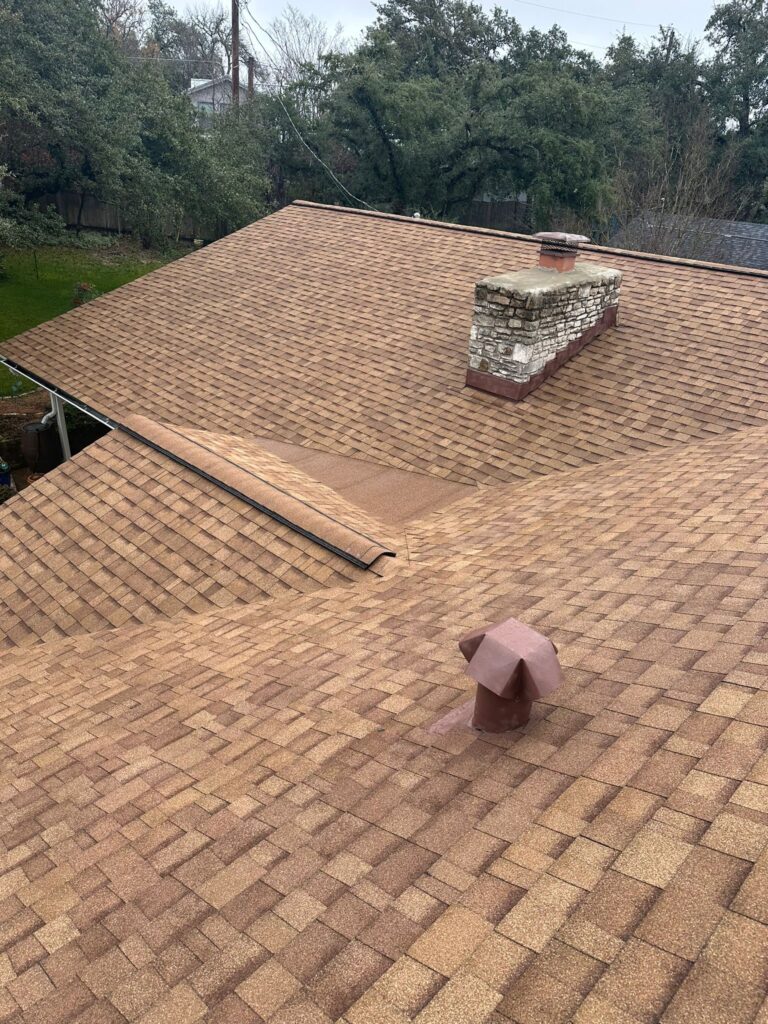Asphalt Shingle Roofing - The Obvious Choice in Austin
Asphalt shingles are a popular roofing material known for their versatility and cost-effectiveness. They consist of a fiberglass mat, topped with asphalt and mineral granules, providing excellent protection against the weather. Available in a range of styles and colors, they can complement any home’s exterior design. These shingles are valued for their ease of installation and maintenance, making them a practical choice for many homeowners. With options from basic three-tab to high-end architectural designs, asphalt shingles cater to a wide array of preferences and budgets.
Types of Asphalt Shingles
There are mainly three types of asphalt shingles that you’ll find on the market:
1. Three-Tab Shingles
These are the most basic and affordable types. They have a pretty straightforward, uniform look and are known for being cost-effective.
3 -tab shingles are available in earth tones including tan, grey, white and black. Usually accompanied with a 25-year warranty, this style of shingle is made to be extremely durable and functional.
3- tab shingles are sized and shaped evenly and are very lightweight. They don’t require much maintenance so you can relax comfortably under your roof for many years to come.

2. Dimensional Shingles
Also called architectural or laminate shingles, these are a step up from the three-tab. They offer a more layered and textured look. They come in various colors and profiles, and they’re currently the most popular type out there.
they are thicker than standard shingles and have a more textured surface. They are also more durable and can last up to 50 years.
Architectural Shingles are moderately priced with a wider aesthetic selection available. They are also longer-lasting and more durable so you may see limited lifetime warranties with architectural shingles.
Some homeowners consider architectural shingles more aesthetically pleasing due to their thicker profiles and a wider variety of shades. They are heavier than 3-tab shingles, making them less likely to be affected by the heavy winds common in Austin, Round Rock, and Cedar Park.

3. Luxury or Designer Shingles
These are the high-end, premium shingles.
They come in a wide variety of styles, colors, and textures. Luxury Shingles mimic the look of slate, tile, or wood shake. They are made from a combination of asphalt and other materials, such as synthetic or natural fiber.
Available at a higher cost, specialty asphalt shingles are usually rated a grade higher than dimensional shingles. If you’re interested in a unique look for your home, designer asphalt shingles are the right choice for you.

What is a Class Impact Resistance?
This rating system is used to measure the durability of asphalt shingles against impact, such as hail.
The impact resistance of asphalt shingles is an important factor, especially in areas prone to severe weather conditions like hailstorms. The impact resistance is classified into four categories, with Class 4 being the highest rating.
Class impact resistance tells us just how much a shingle can handle before it cracks under pressure. Think of it as a rating for shingles – the higher the class, the more they can endure.
The Different Impact Resistance Classes
The difference between the classes is the size of the steel ball used to test them.
Class 1 and Class 2 impact-resistant shingles are designed to offer protection against less severe forms of impact compared to Class 3 and Class 4 shingles. Here’s how they are differentiated:
Class 1 Shingles:
These shingles are tested to withstand the impact of a 1.25-inch steel ball dropped from a height of 20 feet without cracking. They offer basic protection and are suitable for areas where hail is less frequent or less severe.
Class 2 Shingles:
These shingles are tested to withstand the impact of a 1.5-inch steel ball dropped from the same height1. They provide a moderate level of impact resistance and are a step up from Class 1 in terms of protection.
Both Class 1 and Class 2 shingles are generally less expensive. However, they may not offer the same level of durability or potential insurance benefits as the higher classes.
Class 3 Asphalt Shingles:
These shingles are designed to withstand the impact of a 1.75-inch steel ball dropped from a height, simulating the effect of hail. They are crafted with a thicker base mat and more flexible materials, enhancing their durability. They’re an excellent choice for areas prone to hail, offering a higher level of protection against potential damage. Moreover, their robust construction can lead to savings on home insurance premiums, making them a smart investment for long-term home maintenance.
Class 4 Asphalt Shingles:
have to pass the standardized assessment—colloquially known as the “steel ball test.” During this assessment, a 2-inch steel ball is dropped, twice, from a 20-foot height on an installed shingle to evaluate its ability to withstand the impact. The shingle is then examined to see if any damage has occurred and determine a pass or fail. A pass result will show no evidence of ruptures or cracks through the shingles immediately after impact.
This is the highest possible rating level for asphalt shingles.

Which Impact Resistance Shingles Should I Choose?
If you’re a homeowner in an area likely to face hail, shingles that pass the UL2218 Class 4 impact test are a great option. In 2024, these areas included Kansas, Nebraska, South Dakota, and Texas. However, if you don’t live in a stormy area, a Class 4 impact-resistant roof may not be necessary.


